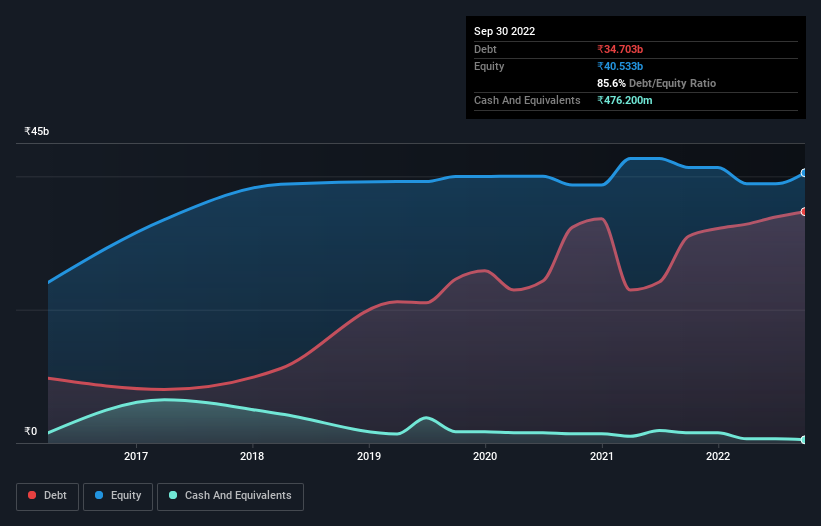Howard Marks put it nicely when he said that, rather than worrying about share price volatility, ‘The possibility of permanent loss is the risk I worry about… and every practical investor I know worries about.’ So it seems the smart money knows that debt – which is usually involved in bankruptcies – is a very important factor, when you assess how risky a company is. Importantly, PC Jeweler Limited (NSE:PCJEWELLER) does carry debt. But should shareholders be worried about its use of debt?
When Is Debt A Problem?
Debt assists a business until the business has trouble paying it off, either with new capital or with free cash flow. Ultimately, if the company cannot fulfill its legal obligations to repay the debt, shareholders could walk away with nothing. However, a more frequent (but still costly) occurrence is where a company must issue shares at bargain-basement prices, permanently diluting shareholders, just to shore up its balance sheet. Of course, the upside of debt is that it often represents cheap capital, especially when it replaces dilution in a company with the ability to reinvest at high rates of return. When we examine debt levels, we first consider both cash and debt levels, together.
See our latest analysis for PC Jeweller
What Is PC Jeweler’s Net Debt?
The image below, which you can click on for greater detail, shows that at September 2022 PC Jeweler had a debt of ₹34.7b, up from ₹31.0b in one year. Net debt is about the same, since it doesn’t have much cash.

How Strong Is PC Jeweler’s Balance Sheet?
Zooming in on the latest balance sheet data, we can see that PC Jeweler had liabilities of ₹37.4b due within 12 months and liabilities of ₹853.8m due beyond that. Offsetting this, it had ₹476.2m in cash and ₹15.8b in receivables that were due within 12 months. So its liabilities total ₹22.0b more than the combination of its cash and short-term receivables.
This is a mountain of leverage relative to its market capitalization of ₹26.0b. This suggests shareholders would be heavily diluted if the company needed to shore up its balance sheet in a hurry.
We use two main methods to inform us about debt levels relative to earnings. The first is net debt divided by earnings before interest, tax, depreciation, and amortization (EBITDA), while the second is how many times its earnings before interest and tax (EBIT) covers its interest expense (or its interest cover, for short) . This way, we consider both the absolute amount of the debt, as well as the interest rates paid on it.
PC Jeweler shareholders face the double whammy of a high net debt to EBITDA ratio (58.1), and fairly weak interest coverage, since EBIT is just 0.11 times the interest expense. This means we’d consider it to have a heavy debt load. Worse, PC Jeweler’s EBIT was down 88% over the last year. If earnings keep going like that over the long term, it has a snowball’s chance in hell of paying off that debt. There’s no doubt that we learn most about debt from the balance sheet. But it is PC Jeweler’s earnings that will influence how the balance sheet holds up in the future. So if you’re keen to discover more about its earnings, it might be worth checking out this graph of its long term earnings trend.
Finally, while the tax-man may adore accounting profits, lenders only accept cold hard cash. So the logical step is to look at the proportion of that EBIT that is matched by actual free cash flow. Over the last three years, PC Jeweler saw substantial negative free cash flow, in total. While investors are no doubt expecting a reversal of that situation in due course, it clearly does mean its use of debt is more risky.
Our View
To be frank both PC Jeweller’s conversion of EBIT to free cash flow and its track record of (not) growing its EBIT make us rather uncomfortable with its debt levels. And furthermore, its net debt to EBITDA also fails to instill confidence. After considering the datapoints discussed, we think PC Jeweler has too much debt. While some investors love that sort of risky play, it’s certainly not our cup of tea. The balance sheet is clearly the area to focus on when you are analyzing debt. But ultimately, every company can contain risks that exist outside of the balance sheet. To that end, you should be aware of the 2 warning signs we’ve spotted with PC Jeweller .
If you’re interested in investing in businesses that can grow profits without the burden of debt, then check out this free list of growing businesses that have net cash on the balance sheet.
Valuation is complex, but we’re helping to make it simple.
Find out whether PC Jeweler is potentially over or undervalued by checking out our comprehensive analysis, which includes fair value estimates, risks and warnings, dividends, insider transactions and financial health.
View the Free Analysis
Have feedback on this article? Concerned about the content? Get in touch with us directly. Alternatively, email editorial-team (at) simplywallst.com.
This article by Simply Wall St is general in nature. We provide commentary based on historical data and analyst forecasts only using an unbiased methodology and our articles are not intended to be financial advice. It does not constitute a recommendation to buy or sell any stock, and does not take account of your objectives, or your financial situation. We aim to bring you long-term focused analysis driven by fundamental data. Note that our analysis may not factor in the latest price-sensitive company announcements or qualitative material. Simply Wall St has no position in any stocks mentioned.